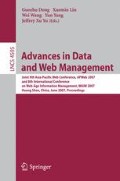Abstract
Web community is intensely studied in web resource discovery. Many literatures use core as the signature of a community. A core is a complete bipartite graphs, denoted as Ci,j. But discovery of all possible Ci,j in the web is a challenging job. This work has been investigated by trawling [1][2]. Trawling employs repeated elimination/generation procedure until the graph is pruned to a satisfied state and then enumerate all possible Ci,j. We proposed a new method that uses exhaustive and edge removal method. Our algorithm avoids scanning dataset many times. Also, we improve crawling method by only recording potential fans to save disk space. The experiment result show that the new algorithm works properly and many new Ci,j can be found by our method.
Access this chapter
Tax calculation will be finalised at checkout
Purchases are for personal use only
Preview
Unable to display preview. Download preview PDF.
References
Kumar, R., Raghavan, P., et al.: Trawling the web for emerging cyber-communities. In: Proceedings of the 8th WWW Conference, Toronto, Canada, pp. 403–415 (1999)
Kumar, R., Raghavan, P., et al.: Extracting large-scale knowledge base from the web. In: Proceedings of 25th VLDB Conference, Edinburgh, Scotland, pp. 639–650 (1999)
Broder, A., Kumar, R., et al.: Graph structure in the web. Computer Networks 33(1-6), 309–320 (2000)
Gibson, D., Kleinberg, J., et al.: Inferring Web Communities from Link Topology. In: Proceedings of the 9th ACM Conference on Hypertext and Hypermedia, Pittsburgh, PA, USA, pp. 225–234 (1998)
Chakrabarti, S., Dom, B.E., et al.: Automatic resource compilation by analyzing hyperlink structure and associated text. Computer Networks 30(1-7), 65–74 (1998)
Dean, J., Henzinger, M.R.: Finding Related Pages in the World Wide Web. In: Proceedings of the 8th WWW Conference, Toronto, Canada, pp. 389–401 (1999)
Reddy, P.K., Kitsuregawa, M.: Inferring Web Community through relaxed-cocition and power-law. Annual Report of KITSUREGAWA Lab., pp. 27–40 (2001)
Flake, G.W., Lawrence, S., et al.: Efficient Identification of Web Communities. In: Proceedings of the 6th ACM SIGKDD Conference on Knowledge discovery and data mining, Boston, MA, USA, pp. 150–160 (2000)
Girvan, M., Newman, M.E.J.: Community structure in social and biological networks. Proc. Natl. Acad. Sci. USA 99, 7821–7826 (2002)
Newman, M.E.J.: Fast algorithm for detecting community structure in networks. Phys. Rev. E 69, 066133 (2004)
Newman, M.E.J.: Detecting community structure in networks. Europe. Phys. J. B 38, 321–330 (2004)
Broder, A.Z., Glassman, S.C., et al.: Syntactic Clustering of the Web. Computer Networks 29(8-13), 1157–1166 (1997)
Author information
Authors and Affiliations
Editor information
Rights and permissions
Copyright information
© 2007 Springer Berlin Heidelberg
About this paper
Cite this paper
Yang, N., Lin, S., Gao, Q. (2007). An Exhaustive and Edge-Removal Algorithm to Find Cores in Implicit Communities. In: Dong, G., Lin, X., Wang, W., Yang, Y., Yu, J.X. (eds) Advances in Data and Web Management. APWeb WAIM 2007 2007. Lecture Notes in Computer Science, vol 4505. Springer, Berlin, Heidelberg. https://doi.org/10.1007/978-3-540-72524-4_30
Download citation
DOI: https://doi.org/10.1007/978-3-540-72524-4_30
Publisher Name: Springer, Berlin, Heidelberg
Print ISBN: 978-3-540-72483-4
Online ISBN: 978-3-540-72524-4
eBook Packages: Computer ScienceComputer Science (R0)

